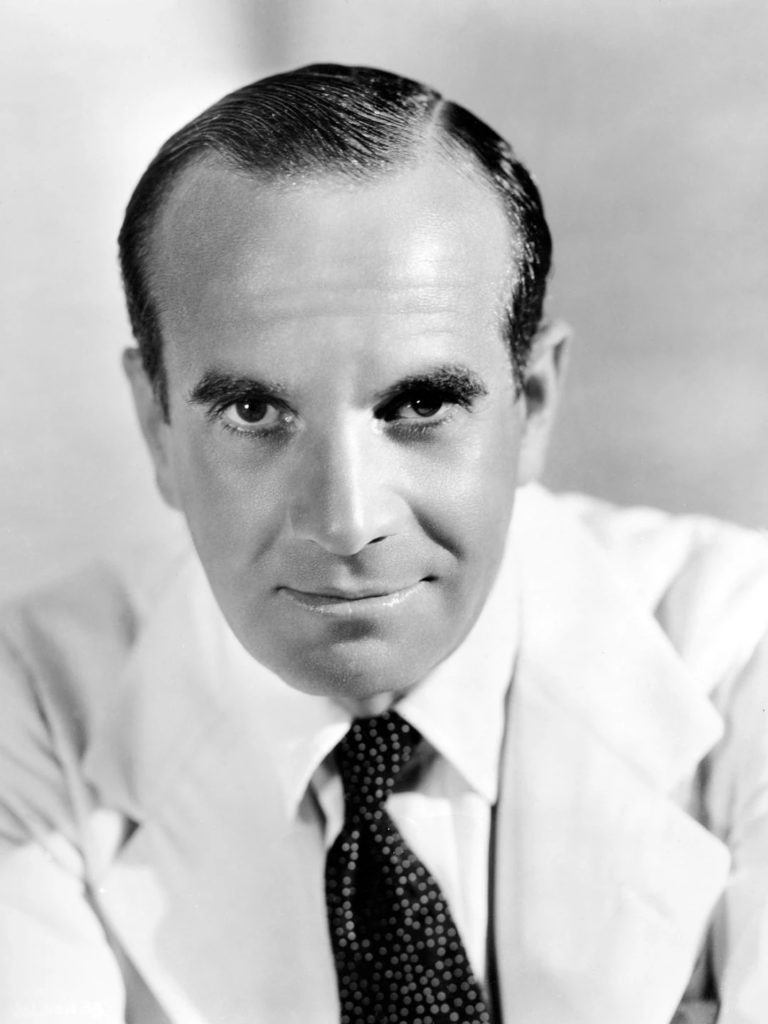
We mark the death on October 23, 1950 – 73 years ago today – of the Lithuanian-American singer and actor Al Jolson. Born “Asa Yoelson” on May 26, 1886, in the village of Srednik, in what was then the Russian Empire and what is today Lithuania, he died of a massive heart attack in his suite at the St. Francis Hotel in San Francisco at the age of 64. He was playing cards with friends when he collapsed; his last words were “Oh … oh, I’m going.”
Singing ran deep in the Yoelson clan; his father Moses Yoelson was a cantor. The family immigrated to the United States in 1894 when young Asa was eight years old.
Jolson grew up in southwest Washington, D.C., where he began his “career” singing on street corners. From there, it was onto burlesque shows and performing on the vaudeville circuit. In those days, entertainment, local retail, and professional sports were among the few American “industries” open to immigrant Jews. If this sounds painfully familiar to Black Americans, well, so it should. Equally painful is that by 1905, the 19-year-old Jolson began appearing in “blackface”: a holdover from the minstrel shows of the nineteenth century. Jolson wasn’t the only performer working in blackface at the time, but he became the best known of his generation, the so-called “king of blackface.”

The subject of tomorrow’s Dr. Bob Prescribes post is Al Jolson’s groundbreaking movie The Jazz Singer. Given that The Jazz Singer concludes with two musical numbers featuring Jolson in blackface, I feel that it’s important to broach this topic – “blackface” – here and now. That’s because the issue of blackface cuts to the heart of racism in America and to the soul of the American popular music industry, going back nearly two hundred years.
Blackface
My views on this subject have evolved; a lot. There was a time, when I was a young man (we’re talking decades ago), when I didn’t think much about it one way or the other. Having grown up in the American northeast, I was surrounded by all sorts of racial and ethnic stereotypes, and to be concerned about them seemed the height of oversensitivity and humorlessness.
So: growing up where and when I did (in the late 1950s and 1960s), I experienced a degree of casually insidious racism that conditioned me (and I daresay most of my generation) to accept a degree of bigotry that would be considered far out-of-bounds today.
For example, cast iron, black faced lawn jockeys dotted the front yards of my South Jersey suburban neighborhood. The book Little Black Sambo was on every toddler’s bookshelf, as were books by Dr. Seuss (Theodore Seuss Geisel, 1904-1991), many of which featured cartoon images of black and Asian people that make us cringe today (an example will appear later in this post). High-end comedians regularly appeared on network TV variety shows like Ed Sullivan, doing routines that today would be considered irredeemably offensive: for example, Buddy Hackett’s Chinese waiter bit and Bill Dana’s “My name is José Jiménez.”
Some old fogies among us might assert that the 1950s and ‘60s were better times, claiming that during those “good ol’ days,” we knew how to laugh at ourselves. But in fact, “we” – meaning, here, straight white people – weren’t laughing at themselves. No: they were laughing at other white people who were making fun of Asian people, Hispanic people, gay people, and – in the case of those wearing blackface – black people.
When I was growing up, blackface imagery was still everywhere to be seen: in the movies, on television, in books and magazines, and at Halloween parties. I took the presence of blackface for granted and was utterly unaware of its origins and how profoundly upsetting it had always been to Black Americans…
Continue, and listen, only on Patreon.
Become a Patron!Listen and Subscribe to the Music History Monday Podcast
Podcast: Play in new window
Subscribe: Apple Podcasts | Spotify | Pandora | iHeartRadio | RSS | More
The Robert Greenberg Best Sellers
Best selling products
-
Mozart In Vienna
-
Great Music of the 20th Century
-
Understanding the Fundamentals of Music
-
Music as a Mirror of History
-
How to Listen to and Understand Great Music, 3rd Edition
-
Great Masters: Mahler — His Life and Music
-
The Chamber Music of Mozart
-
The Concerto
-
The 30 Greatest Orchestral Works
-
Beethoven’s Piano Sonatas










